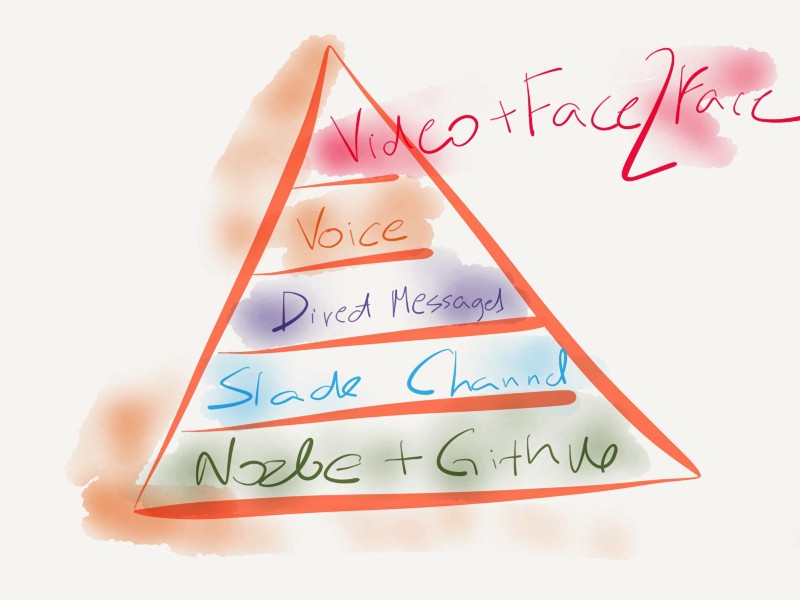For years, email was the primary means of digital communication within companies. About 15 years ago, more companies started using browser-based intranets. In recent years, though, messenger and chat have since taken the lead in the workplace.
Asynchronous and Synchronous Communication
Email and intranet are asynchronous types of communication. After a message is sent, the sender doesn't wait for a recipient's reply. Instead, he might go and do other things in between.
In telecommunications, asynchronous communication is transmission of data, generally without the use of an external clock signal, where data can be transmitted intermittently rather than in a steady stream.
The very first intranet sites were so static that it sometimes took weeks to update content. In the meantime, employees got their information elsewhere. This led to the intranet becoming a less attractive communication medium. Content management systems were also complicated, requiring specially trained staff just to create and modify pages. Thus, email remained the preferred means of communication until recently, and it has been and is still used in ways that were not originally planned. One example is synchronous communication.
In telecommunications, a synchronous network is a network in which clocks are controlled to run, ideally, at identical rates, or at the same mean rate with a fixed relative phase displacement, within a specified limited range.).
Every now and then, there's that co-worker who might come to your desk and abruptly ask, "Didn't you get the email I sent five minutes ago? Why didn't you didn't reply?” When someone sends “chain mail” with multiple recipients and CCs, communication in the office can quickly get confusing.
There are a variety of tools for different types of synchronous communication. Michael Sliwinsky, the CEO of Nozbe, describes in, "The Pyramid of Communication in a Remotely Working Team," the tools that are used at each level of communication in his company:
-
Level 1 - Asynchronous communication tools (Nozbe as the task tool and Github for code management).
-
Level 2 - Slack channels for group chats, to which workers can react immediately, or come back to later.
-
Level 3 - Direct messages exchanged with Slack, iMessage or other software.
-
Level 4 - Synchronous voice conversations via Skype, FaceTime, or telephone.
-
Level 5 - Top of the pyramid: synchronous and rich communication, such as video or in-person communication.

The Pyramid of Communication in a Remotely Working team (Photo courtesy of Michael Sliwinski)
Email, according to Nozbe, is no longer number one in terms of internal communication, because other tools are better suited for the company's different demands (see Sliwinsky's article, “How Banning Email Improves Team productivity”).
Messenger and chat
Why does Nozbe, a relatively small company (about 20 employees), have so many different tools in use? It's because Nozbe doesn't have a physical location. Instead, the employees come from all over Europe working in their own home offices. That's why they need a variety of synchronous communication tools with different levels of synchronization and “communication bandwidths” along with asynchronous tools for task planning and editing. For example, employees can go back to video conferences in order to see the facial expressions, body language and gestures of their coworkers.
Depending on which tool is used, video streams can be transferred, conferences planned in the calendar, and documents can be shared, or even collaboratively edited. More employees can chat using their keyboards, via voice and video calls, and send each other messages to collaborate on tasks. Though there aren't many businesses that have employees working entirely from home, the proportion of those doing so is growing.
Beginning in the 1980s, IRC (Internet Relay Chat), gave many students the ability to communicate in text. Commands were transferred to the server in text (i.e. /whois Nickname). However, neither the technology nor the bandwidth could support more than text transmissions. In the business world, though, messenger programs did not take over as the primary communication medium. With the arrival of graphical user interfaces, chat spread rapidly among private users. There have been, and still are, many different messenger programs like those from AOL, Microsoft, and Facebook. The strong growth in private use was mostly due to:
-
Technological advances bringing about very powerful, small devices.
-
Greatly increased available bandwidth.
Today, different chat and messenger programs are very powerful and match each other in terms of features.
-
Group or private chats are possible.
-
Along with text, there is also synchronous audio (IP Telephony) and video communication.
-
Group rooms or channels enable subject-based communication in separate rooms (i.e. with authorization).
-
Voice or video messages (messages that can be viewed or listened to later).
-
Broadcast messages allow for content sharing similar to newsletters via email (see Whatsapp).
-
Chatbots make automated communication possible
Among private users, messaging, IP telephony, and video conferencing quickly began to spread with the popularity of Skype. It started out as an a quick and easy means of informal communication.
Messenger and chat in the workplace
Eventually, large companies started using messenger services. Overall usage took a giant leap forward, often due to the effort of organizations wanting to introduce Unified Communications and other ISDN technologies. It was a long time, however, before all large companies could attain the respective infrastructure and proper know-how. Traditional providers of such solutions are Cisco, IBM, and Microsoft.
In many ways, both private-use and professional solutions have grown much closer in design. User interfaces are becoming more similar to each other, and the required hardware for the respective client software differs very little. In 2011, when Microsoft took over Skype, Skype for Business' client software (professional solution, formerly Lync) and the classic Skype client were very similar. As long as this remains the case, Skype and Skype for Business users can continue to communicate with one another.
At the same time, there are even more business solutions that are either inexpensive or easy for small to mid-sized businesses to use in their own data centers and as cloud solutions. There is even the possibility for employees to work and communicate more often from home or on the road. Nearly every chat or messenger program has apps for mobile devices such as smart phones and tablets.
As seen in the Nozbe example, chat and messenger programs can be used for a number of purposes – both in synchronous and asynchronous communication. Some other ways are:
-
Through regular display of availability (for example "Online", "Away", "Busy"), avoiding disturbances ("do not call", even though you're sitting at your desk). There are even lights on your desktop to show coworkers that you're busy.
-
Work conferences are not only for discussion, but also for editing documents.
-
Messages are sent from management via video.
-
Project communication happens in group rooms.
-
Quick meetings with suppliers, contractors or clients are common.
-
Chatbots could also be used within companies in the future. On-boarding assistants could answer questions from new employees, or even appointment bots that coordinate meetings with several participants are very plausible.
In terms of bots, there are many ways to meet the daily demands of communication (even if it takes some time for bots to truly work reliably).
 Original article “Messenger und Chat im Unternehmen″ published in German by Frank Hamm.
Original article “Messenger und Chat im Unternehmen″ published in German by Frank Hamm.
Frank Hamm is a consultant for communication and collaboration who supports companies in their digital transformation. He has written for INJELEA-Blog about social business, intranets, enterprise 2.0 and company communication practices since 2005. Frank is an avowed nexialist and writes about this at Der Schreibende.
You can find more articles by Frank Hamm in our intranet special.
Further information
Comparison of HipChat, Slack, Jabber, XMPP, Lync, Skype for Business, Whatsapp and
Other group chat solutions
99 Arguments for HipChat in Corporations


